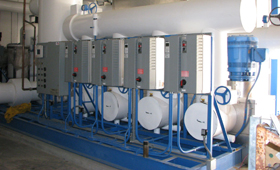Hybrid Cooling System Saves District Money
WEEKI WACHEE, Fla. — For its new high school campus in Weeki Wachee, Hernando County School District in Florida chose hybrid cooling for its temperature regulation needs — a move that earned it an award from the region’s HVAC and refrigeration technical society and LEED Silver certification.
The district earned the Central Florida ASHRAE Chapter Institutional Building Technology Award for its 450,000-square-foot campus, which features a “high school as a small town” design concept drafted by SchenkelShultz architectural firm.
The facility features three academic neighborhoods, an administration and media civic center, athletic and dining facilities, and a performing arts town  center clustered around a central landscaped courtyard.
center clustered around a central landscaped courtyard.
Designers installed various energy-efficient technologies during the design phase of the campus, including hybrid cooling, solar domestic water heaters, low-flow water fixtures in all restrooms, and high-efficiency T-8 and T-5 internal lighting.
To take advantage of cooling load diversity and economies of scale, the high school and adjoining K-8 campus operate with a combined chilled water central energy plant from Calmac, a designer and manufacturer of thermal energy storage.
By building one central energy plant for both the high school and kindergarten through eighth grade school, the district realized a first cost savings of $400,000. In addition, by operating one plant instead of two, the tonnage diversity in the system causes a $48,000 energy cost savings per year, according to officials from Calmac.
The cooling plant utilizes a hybrid cooling system made of Calmac IceBank energy storage tanks and chillers, which uses chillers to charge the IceBank at night to fill it with ice. The stored energy in the ice serves as thermal energy to augment the cooling system when cooling demands are high, helping to keep electric demand and cooling costs low.
The system acts similar to a hybrid car design, where the stored energy “picks up the slack” when more than average demands are required, according to officials from Calmac.
On a peak design day, the system’s air-cooled chillers cool up to 70 percent of the facility’s load and the energy storage cools the remaining load – a process known as partial energy storage.
The partial energy storage process allows downsized chillers to operate at or near full load continuously, which eliminates inefficient cycling and capacity modulation that comes with part-load operation and normally causes a chiller to operate at peak efficiency only 25 percent of the time.
The air-cooled chillers used at Weeki Wachee High School make for great “icemakers” because they take advantage of reduced dry bulb temperatures at night while making ice, according to company officials.
The combined campuses at Weeki Wachee require 2,040 total tons of cooling capacity.
Matern Professional Engineering, a Fla.-based service firm, combined two central cooling plants into one and added energy storage, reducing the purchased chiller capacity to 1,200 tons.
In addition to reducing the HVAC equipment size and refrigerant required for the project, the hybrid cooling system added to classroom comfort by lowering humidity levels and reduced the peak energy consumption for the campus.
 Ccalmac’s energy storage tanks are estimated to save 10 percent of the school’s annual electricity costs, company officials reported.
Ccalmac’s energy storage tanks are estimated to save 10 percent of the school’s annual electricity costs, company officials reported.
One of the main challenges was selecting equipment that would save energy while also reducing energy costs to provide a payback on investment for the community, officials said.
While the goal of the project was to achieve a 12 percent reduction in energy costs, the most recent energy calculations showed a 17.4 percent reduction and a cost savings of 20 percent, which includes 43 million British thermal units of on-site renewable energy from solar panels. The total water savings is 44.8 percent, Calmac officals report.
The school, which opened in August 2010, was able to extend its ability to melt more ice during the occupied mode than originally expected by optimizing the plant with the DDC control system. Energy modeling shows that the energy storage system is also saving 6 percent to 7 percent of energy, company officials said.
Dennis McGeehan, principal of Weeki Waachi High School, said the system has been operating smoothly.
“We’re very pleased with it at this point,” he said.
Key Players:
Mark Johnson, Regional Sales Manager
CALMAC
Ryan Strandquest, LEED AP, Project Manager
Matern Professional Engineering, Inc.
Kevin Bjorgum, PE, Mechanical Engineer of Record
Marc Sherman, EI, LEED AP, Mechanical Engineer and LEED Representative
